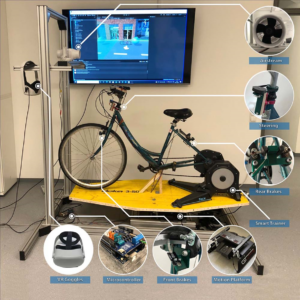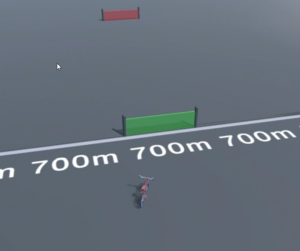The Eternity Bike
The “Eternity Bike” is our vision of a self-driving function for bicycles, which could be used for a wide range of applications in the future. This includes active safety support (such as anti emergency braking, adaptive speed control, or lane keeping assistance), but also less obvious features (for example, enabling two-wheelers for disabled people who could not ride a standard bike).
In addition, we want to use this project to investigate cyclist support systems to increase rider comfort (for example, provision of navigation instructions, relevant places in the vicinity, etc.) and safety (for example, communicating the intent of other traffic participants such as automated vehicles).
Currently, we the Eternity Bike project is split into two parallel phases. First, we have developed a VR-bicycle simulator which we can use to concuct laboratory study with human subjects without the risk of injuries. The simulator consists of a standard bike placed on a bike trainer and a motion platform. Additionally, to increase the perceived realism, we developed an airstream simulation and a motor control for the handlebar to simulate forces.
A first study addressing the question whether simulator tilt is beneficial for users has been conducted, yielding to positive results – in the future, we will conduct additional studies to evaluate the appropriateness of different tilt and pitch functions, as well as prototypical implementations of various cyclist support systems.


Simultaneously, we are developing a self-balancing function using artificial intelligence, in particular, reinforcement learning. Aim of the agent is to balance by controlling the handle bar while successfully navigating through different locations. Virtual sensors (accelerometer, gyroscope, handle bar rotation) on the bike are used so that the agent can observe the state of the environment.
Currently, we are trying to replicate this approach on a real bicycle.